The 2007 crisis in the U.S. retail mortgage market has had a significant impact on the secondary market for commercial real estate assets, primarily by freezing the CMBS market. As of the third quarter of 2007 there has been little effect on the primary market for CRE assets and CRE portfolios have not been significantly impaired. This may not last. Historically, a downturn in the retail market has been followed approximately five quarters later by a downturn in the CRE market. Given this warning, CRE lenders can either resign themselves to the end of a boom, or act now to minimize the losses.
Action can happen on three levels:
* Changing the origination of new assets
* Restructuring whole portfolios of existing assets, or
* Restructuring individual existing assets.
In the origination of new assets lenders have a wide range of choices. The most obvious is to not do the deal, but if they want to stay in business they can do the deal with added safeguards such as reserve accounts, sinking funds, sweeps, hedges and covenants. Given the customer's dislike of such safeguards, the difficulty is in knowing how much safety is enough without driving the customer away.
In managing the portfolio of existing assets at a macro level the options are more limited. There is little time to realign the portfolio gradually by not renewing assets in one area and instead diversifying into a different area. Until recently other alternatives would have been to sell or secure some of the assets, use default swaps or even use the nascent market in property-index derivatives. Such options, however, are severely limited in the current illiquid market. Even letting the portfolio re-align itself by not refinancing loans when they mature has its dangers because, if a loan is not good enough for this portfolio, the chances are that no one else will take it.
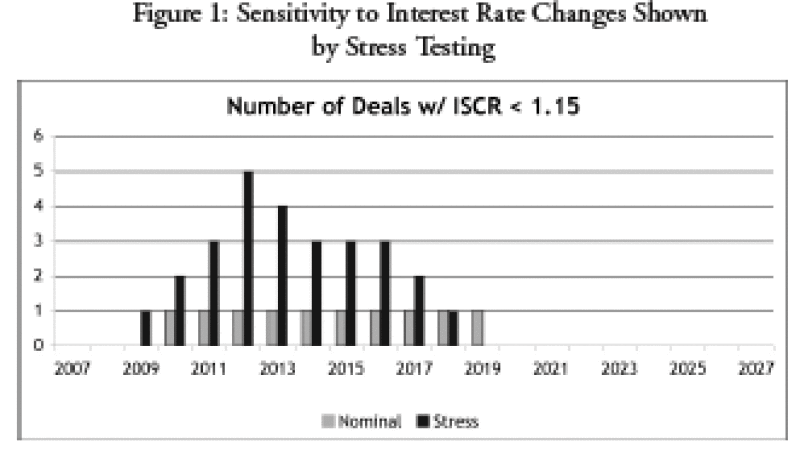
For portfolio management at the macro level, the most viable course of action could be to use liquid instruments that have cash flows that are correlated with the losses from the loans. If, for example, the portfolio loss rate is expected to increase when interest rates increase, then buying an interest rate cap will provide income to the portfolio at times when the losses are high. The other alternative is to not act at the portfolio-level but rather to go down to the deal-level and examine what can be done about the individual loans that make up the portfolio.
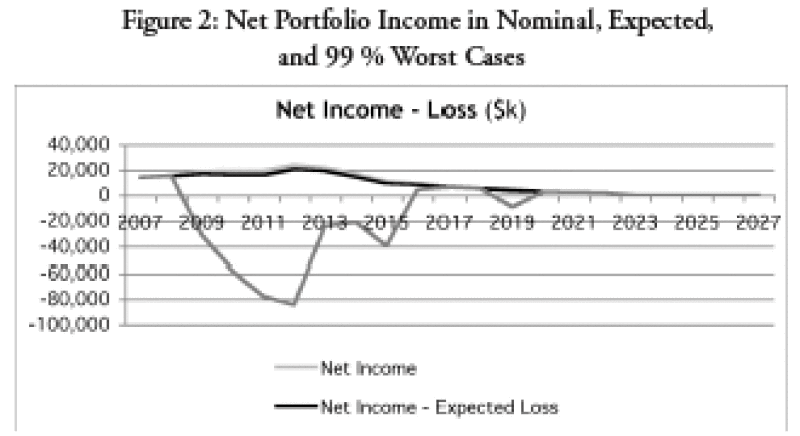
At the deal-level it is theoretically possible to use all the structuring mechanisms that are available when originating new deals, e.g., adding sinking funds and sweeps. However, there need to be incentives for the borrower and the lending officers to make the restructuring actually happen. The incentive for the borrower can be to offer a reduction in the margin. In return for adding a safety feature, the lender should be prepared to offer a reduction in margin up to the amount by which the risk of the loan will be reduced. Given the expenses and overhead associated with a default, the avoided cost of a default should easily cover a useful reduction in margin. There also needs to be an incentive for the lending officers to spend their time reworking old assets rather than originating new assets. This will be automatic if bonuses have been historically linked to default rates, however, if this is not the case, lending officers can still be rewarded for reducing the risk in the portfolio. For example if a five-year $100M loan is restructured so that its expected loss rate falls from 2% to 1% per year, this is roughly equal to a saving of $5M for the institution. Part of that saving can be passed on to the loan officers who instigated the restructuring. This could be in the form of a direct cash amount, or indirectly through a reduced cost of funds due to the savings in capital and provisions. But to give incentives linked to changes in risk, the difficulty is again in quantifying the saving for any given change in structure.
Overall, the portfolio manager needs to quantify the magnitude of risk in the portfolio, identify the causes of risk, identify the assets containing the risk, and then quantify the alternatives for restructuring. The following section shows how advanced risk measurement tools can guide these decisions both at the level of the overall portfolio and for individual assets.
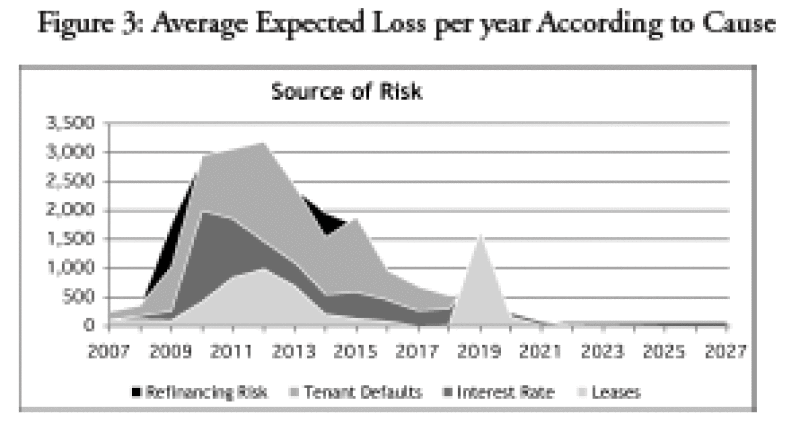
The figures below show several ways of identifying the risk in a portfolio. This illustrative portfolio has only 10 significant assets, but we also use this approach on portfolios of thousands of assets. The first figure shows the results of a stress test. The modest stress is an increase in interest rates of 0.25 % per year and a fall in property values of 10 %. The graph projects the number of assets that would have an interest service cover ratio (ISCR) of less than 1.15 in both the nominal (non-stress) case and the stress case. It shows that this portfolio has significant vulnerability to interest rate movements.
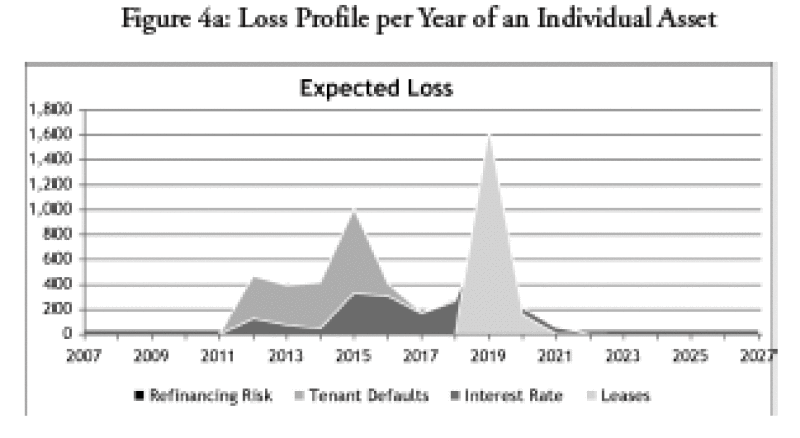
The second figure shows the projection of net margin income to the portfolio over the next 20 years. The income reduces naturally as the portfolio matures and the balances reduce. Three cases are shown: the nominal case without defaults, the expected case with the average default rate, and the 99 % worst case. This shows a significant risk of negative income.
The third figure shows the portfolio's average expected loss per year broken out according to whether the loss is triggered by a change in leases, interest rate movements, tenant default or failure to refinance. This figure shows that there is a significant risk due to tenant defaults and also confirms that interest rate movement is a significant source of risk. Given this insight, the portfolio manager could try adding different interest rate swaps as macro hedges to see the effect on the net cashflows of the portfolio as a whole.
If instead the portfolio manager wants to act on the individual assets, the risk can be broken out to identify the assets that are the main sources of risk. This information can be used to direct the portfolio manager to the deal teams responsible for the most influential assets.
Once a significant asset has been identified, similar analyses can be run to guide the restructuring of that asset. Figure 4a shows the average loss profile of one of the assets as it is currently structured. Figure 4b shows the profile of the same asset if a cap was added. The risk reduction for this deal is a 17 % reduction in the NPV of losses. Alternatively the lending officers can try other changes in the structure e.g., adding reserves to bridge lost income after tenant defaults. Once they find an option that gives a significant reduction in risk they can start negotiating with the customer, knowing how much margin they would be prepared to give up.
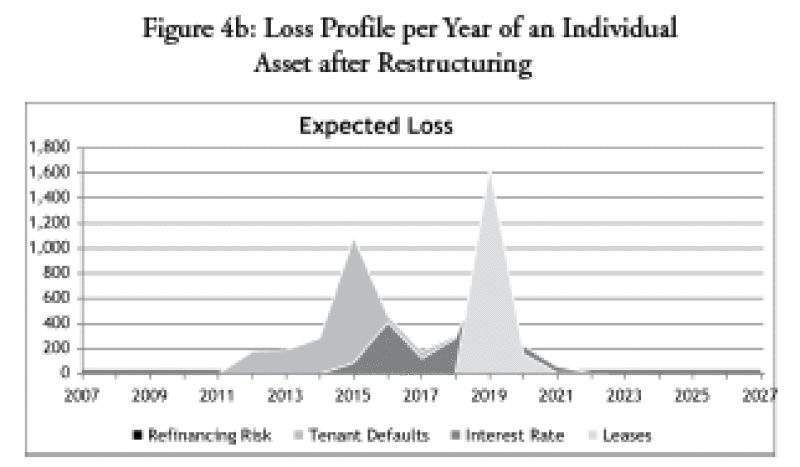
The portfolio manager can also give guidance by running "what if" scenarios to find structures that if applied across the portfolio would give a significant reduction in risk. Figures five and six show the same portfolio graphs as before but with caps added to all of the individual assets. The result is a much lower loss rate and a much more survivable 99 % loss in income.
By acting now to restructure the risk in the CRE portfolio, lenders can not only minimize their losses, but by reducing the number of troubled assets, minimize the severity of the crash as a whole. But this has to be done soon. If the historical pattern holds and the CRE market crashes five quarters after the retail market, then the summer of 2008 will be a time of reckoning.
This week's guest column was written by Dr. Chris Marrison, founder and ceo of Garrison, N.Y.-based Risk Integrated.
